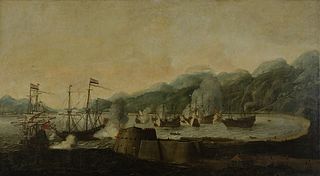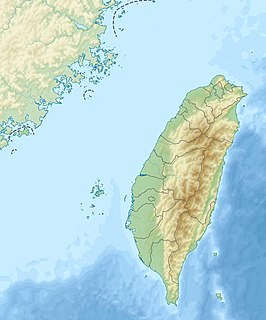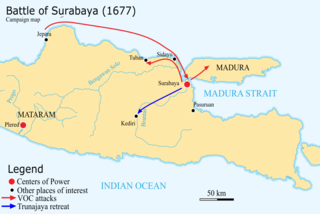 W
WThe 1678 Kediri campaign took place from August to December 1678 in Kediri during the Trunajaya rebellion. The forces of the Mataram Sultanate, led by Amangkurat II, and the Dutch East India Company (VOC), led by Anthonio Hurdt, marched inland into eastern Java against Trunajaya's forces. After a series of marches beset by logistical difficulties and harassment by Trunajaya's forces, the Mataram–VOC army crossed the Brantas River on the night of 16–17 November. They then marched on Trunajaya's capital and stronghold at Kediri and took it by direct assault on 25 November. Kediri was plundered by the Dutch and Javanese victors, and the Mataram treasury—captured by Trunajaya after his victory at Plered—was completely lost in the looting. Trunajaya himself fled Kediri and continued his greatly weakened rebellion until his capture at the end of 1679.
 W
WThe Battle of Goa refers to a series of naval engagements between the Portuguese Armada and the Dutch East India Company fleets attempting to blockade and conquer the city of Goa. In 1638, forces commanded by the Viceroy of Portuguese India, D. Pedro da Silva and later António Teles de Meneses, fought off a large Dutch fleet sent to block the port colony of Goa, commanded by Admiral Adam Westerwolt, who was badly defeated at this encounter. The next year 1639, the Dutch Admiral Cornelis Simonsz van der Veere would conduct a new raid on Goa's port.
 W
WThe Battle of Macau in 1622 was a conflict of the Dutch–Portuguese War fought in the Portuguese settlement of Macau, in southeastern China. The Portuguese, outnumbered and without adequate fortification, managed to repel the Dutch in a much-celebrated victory on 24 June after a three-day battle. The battle is the only major engagement that was fought between two European powers on the Chinese mainland.
 W
WThe Battle of Vågen was a naval battle between a Dutch merchant and treasure fleet; and an English flotilla of warships in August 1665 as part of the Second Anglo-Dutch War. The battle took place in Vågen, the main port area of neutral Bergen, Norway. Due to a delay in orders, the Norwegian commanders took the side of the Dutch, contrary to the secret intentions of the King of Norway and Denmark. The battle ended with the retreat of the English fleet, which was much damaged but had lost no ships. The treasure fleet was relieved by the Dutch home fleet 17 days later.
 W
WThe Battle of Cape Rachado, off the present-day Malaccan exclave of Cape Rachado in 1606, was an important naval engagement between the Dutch East India Company and Portuguese fleets.
 W
WThe Battle of Colachel was fought on 10 August 1741 [O.S. 31 July 1741] between the Indian kingdom of Travancore and the Dutch East India Company. During the Travancore-Dutch War, King Marthanda Varma's (1729–1758) forces defeated the Dutch East India Company's forces led by Admiral Eustachius De Lannoy on 10 August 1741. The Dutch never recovered from the defeat and no longer posed a large colonial threat to India.
 W
WThe Battle of Liaoluo Bay took place in 1633 off the coast of Fujian, China; involving the Dutch East India Company (VOC) and the Chinese Ming dynasty's navies. The battle was fought at the crescent-shaped Liaoluo Bay that forms the southern coast of the island of Kinmen. A Dutch fleet under Admiral Hans Putmans was attempting to control shipping in the Taiwan Strait, while the southern Fujian sea traffic and trade was protected by a fleet under Brigadier General Zheng Zhilong. This was the largest naval encounter between Chinese and European forces before the Opium Wars two hundred years later.
 W
WThe Battle of Ronas Voe was a naval engagement between the English Royal Navy and the Dutch East India ship Wapen van Rotterdam on 14 March 1674 in Ronas Voe, Shetland as part of the Third Anglo-Dutch War. Having occurred 23 days after the signing of the Treaty of Westminster, it is likely to have been the final battle of the Third Anglo-Dutch War.
 W
WThe Siege of Batavia was a military campaign led by Sultan Agung of Mataram to capture the Dutch port-settlement of Batavia in Java. The first attempt was launched in 1628, and the second in 1629; both were unsuccessful.
 W
WThe Battle of Surabaya was fought in May 1677 during the Trunajaya rebellion, in which the Dutch East India Company defeated the forces of Trunajaya and took Surabaya on behalf of its ally, the Mataram Sultanate.